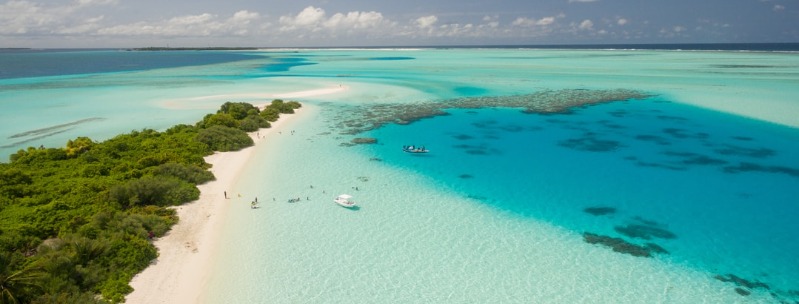Caribbean Beach Vacation Guide
Palm trees swaying over white-sand beaches, pellucid waters with teeming reefs just a flipper-kick from the shore, and killer rum cocktails brought right to your lounge chair – this is the Caribbean, as per everyone’s favorite tropical fantasy.
Given these obvious draws, a vacation in the Caribbean – anywhere in the Caribbean – is commonly referred to as the ultimate getaway. Free Fun Guides provides information on the following Caribbean beaches, sorted by country, island, and resort:
Anguilla Beaches
Barely 35 square miles in size, and rising to the highest point of just over two hundred feet, Anguilla has an interior that is dry, dusty, and covered in scrubby vegetation. However, this fact is largely ignored by an increasing stream of visitors who beat their way here for the glorious turquoise waters and truly stunning beaches.
Some of the beaches, particularly Rendezvous Bay in the southwest and Shoal Bay in the northeast, are among the finest in the Caribbean.
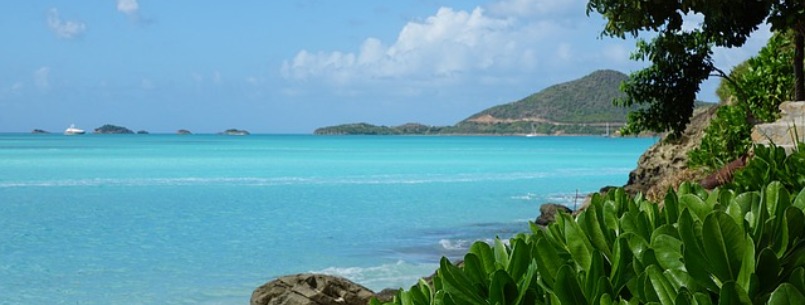
Long ignored by tourists, tiny Anguilla has benefited from careful study of the planning mistakes that have badly damaged neighbors like St. Maarten, where runaway development has led to rising crime and serious social problems.
By contrast, Anguilla has eschewed large-scale tourist complexes, successfully aiming for top-quality, high-end development with relatively limited impact on the island’s scarce resources. As a result, the island feels very safe, welcoming, and relaxed.
If you’re happy with beach wandering, watersports, and plenty of good restaurants, Anguilla is hard to beat.
Like other Caribbean islands, Anguilla is a year-round destination; however, the best time to visit is between mid-December and mid-April when rainfall is low and the heat is tempered by cooling trade winds.
Antigua & Barbuda
Famous for its beaches, tiny Antigua is now one of the Caribbean’s most popular vacation destinations. Dozens of hotels and restaurants have sprung up around the coastline, there’s a smart airport, and a number of outfits run boat and catamaran cruises and scuba-diving and snorkeling trips to the island’s fabulous coral reefs.
Tourism makes a firm impression on Antigua’s west coast, with hotels dotted at regular intervals between the little fishing village of Old Road in the south and the capital, St John’s.
Two features dominate the area: a series of lovely beaches, with Darkwood probably the pick of the bunch for swimming, snorkeling, and beachcombing.
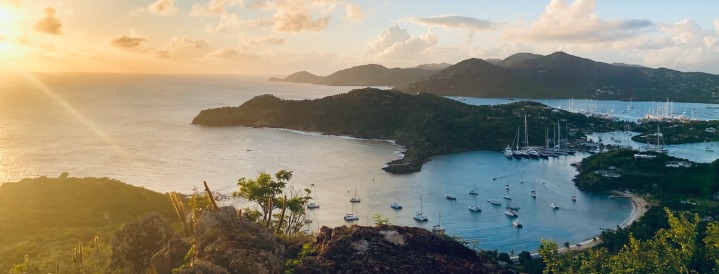
Due west of St John’s, the Five Islands peninsula holds several hotels, some good beaches, and the substantial ruins of the eighteenth-century Fort Barrington.
North of St John’s, Runaway Bay and adjoining Dickenson Bay constitute the island’s main tourist strip, with a couple of excellent beaches, a host of good hotels and restaurants, and plenty of action.
With its magnificent and often deserted beaches, its spectacular coral reefs, and its rare colony of frigate birds, the nation’s other inhabited island, Barbuda – 48km to the north of Antigua – is a definite highlight of any visit to Antigua.
Aruba
With its seemingly endless supply of white sandy beaches and turquoise blue waters, Aruba is one of the more popular Caribbean vacation destinations for many sun-worshipers and cruise ship passengers.
The smallest of the ABC islands, Aruba is 25km north of Venezuela and only 30km wide. Over one million visitors a year come to this tiny island of 90,000 to indulge in the glitz associated with its luxurious beachside resorts, elegant restaurants, 24-hour casinos, shops, and boutiques.
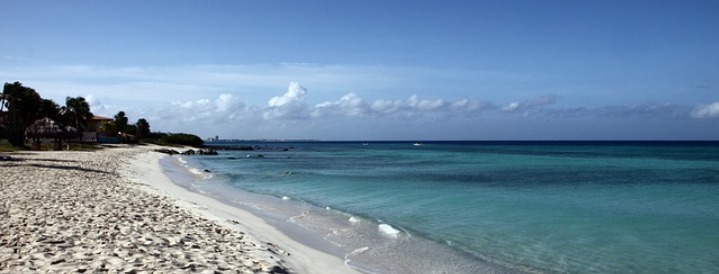
The harborside capital Oranjestad attracts many visitors, as do resort-filled Eagle and Palm beaches just north of town.
Here, Aruba’s best 7km of fine white sand stretches between Eagle Beach and Palm Beach and meets up with the turquoise waters of the Caribbean.
Further northwest, good conditions coupled with a handful of colorful coral reefs and sunken ships, attract windsurfers, divers, and snorkelers.
Perhaps the most photographed attraction on the island is the Natural Bridge. Rising 25 feet above sea level and spanning a hundred feet across a small bay, this natural coral archway was carved by centuries of raging surf, strong winds, and tectonic processes that continue to shape it today.
A sandy beach, accessible by a set of stairs from the parking lot, allows visitors to take close-up pictures. The more adventurous can walk the entire length of the bridge and experience first-hand the powerful force of the pounding surf.
About 6km east of San Nicolas (the largest city in Aruba), are two small popular public beaches. To reach them, take Fortheuvelstraat out of town until you come to a huge cement anchor at the end of the road. Turn right on the main road and follow the signs to Rodger’s Beach and Baby Beach.
You’ll first hit Rodger’s Beach, which, despite a view of the nearby oil refinery, is a good spot with decent swimming conditions and the Coco Bar and Grill Restaurant.
Just east of here, the sheltered waters of Baby Beach offer ideal swimming conditions, especially for families with small children, as well as good snorkeling.
Bahamas
The Bahamas islands are well established as one of the world’s top draws for both intrepid explorers and casual vacationers, graced with beautiful pink sand beaches, evocative windswept panoramas, and countless opportunities for diving, snorkeling, and fishing.
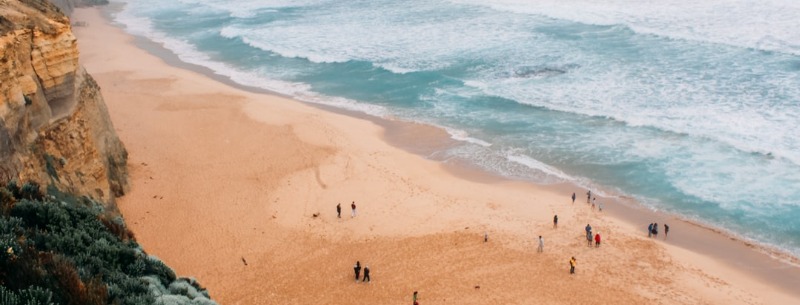
The Bahamas, an island chain that begins just 55 miles east of Miami, Florida, offers a variety of tourist hotels, all-inclusive resorts, and even rustic lodges, making staying there a relatively simple endeavor.
The Bahamas consist of approximately 700 islands, only thirty of which are inhabited, as well as smaller cays (pronounced “keys”) and rocks – an impressive arc stretching from just beyond Florida’s Atlantic coast to the outlying waters of Cuba, where Great Inagua lies only sixty miles offshore.
Barbados Beaches
Tourists pour into Barbados from all over the world, drawn by the delightful climate, the big blue sea, and the brilliant white sandy beaches.
The people of Barbados, known as Bajans, take great pride in their tiny island of 430 square kilometers and 250,000 people, which has produced writers like George Lamming, calypsonians like the Mighty Gabby, and great cricket players.
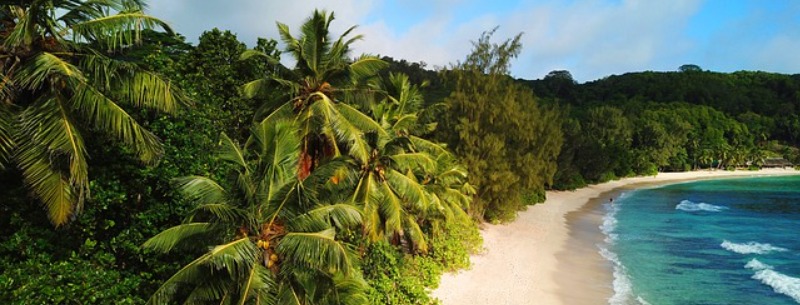
Tourism plays a major part in the country’s economy and revenues have been put to good use. The infrastructure and public transport are first-rate and there is no sign of the poverty that continues to bedevil some Caribbean islands.
Development has mostly been pretty discreet, many of the facilities are Bajan-owned, and there are no private beaches and no sign of American fast-food franchises.
Belize Beaches
Wedged into the northeastern corner of Central America between Mexico’s Yucatбn peninsula and the Petйn forests of Guatemala, Belize offers some of the most breathtaking scenery anywhere in the Caribbean.
The country actually consists of marginally more sea than land, with the dazzling turquoise shallows and cobalt depths of the longest barrier reef in the Americas just offshore.
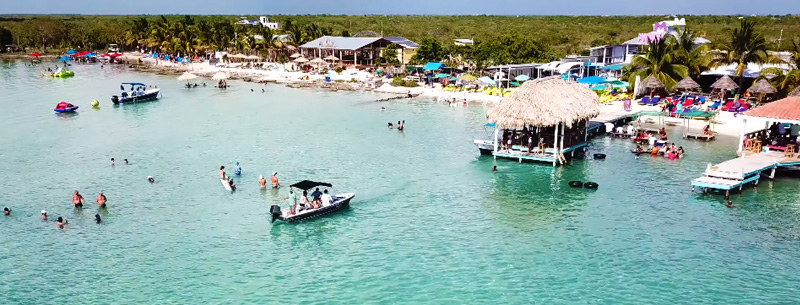
Here, beneath the surface, a brilliant, technicolor world of fish and corals awaits divers and snorkelers. Scattered along the reef, a chain of islands – known as Cayes – protect the mainland from the ocean swell and offer more than a hint of tropical paradise.
Beyond the reef lie the real jewels in Belize’s natural crown – three of only four coral atolls in the Caribbean.
Although Belize is the second-smallest country in Central America, the wealth of national parks and reserves, the numerous small hotels and restaurants, together with plenty of reliable public transport make Belize an ideal place to travel independently, giving visitors plenty of scopes to explore little-visited Caribbean islands as well as the heartland of the ancient Maya.
Compared to many other islands in the Caribbean, the beaches of Belize are neither the biggest nor the widest, but they are relaxing, with very clear water.
Areas that offer the best beach sunbathing are in the Cayes, including Ambergris Caye, Caye Caulker, Tobacco Caye, Dangriga, and Placencia.
Bonaire Beaches
Regarded as one of the world’s premier sites for shore diving, the tiny boomerang-shaped island of Bonaire, located 80km north of Venezuela, has much to offer those seeking an active tropical holiday.
Beneath the clear blue waters, divers and snorkelers are treated to a stunning spectacle: schools of fish of every imaginable shape, size, and color swim with sea turtles and other marine creatures in and around the delicate coral and sponge gardens.
All this and more can be found in the waters of the Bonaire Marine Park, which surrounds the entire island and its neighboring offshore cay, the uninhabited Klein Bonaire.
As rugged and barren as the land may seem, the island has a different character to it depending on where you are.
In the hilly north, the cactus-strewn landscape of Washington-Slagbaai National Park preserves remnants of the island’s history along with a host of local flora and fauna.
To the south, the land opens up and becomes flatter, and vast multicolored saltpans attract the largest colony of pink flamingos in the Caribbean.
If you’re after more adventure, there’s windsurfing at Lac Cai, on the island’s east coast, and kayaking in the nearby mangrove swamps.
British Virgin Islands
Forming roughly two chains separated by the Sir Francis Drake Channel, the British Virgin Islands are a haven for snorkeling, fishing, and diving enthusiasts.
The British Virgin Islands also offers some of the best sailings in the world and the towns and bays bustle with the constant comings and goings of yachts and cruise ships mooring up at the many marinas and anchorages.
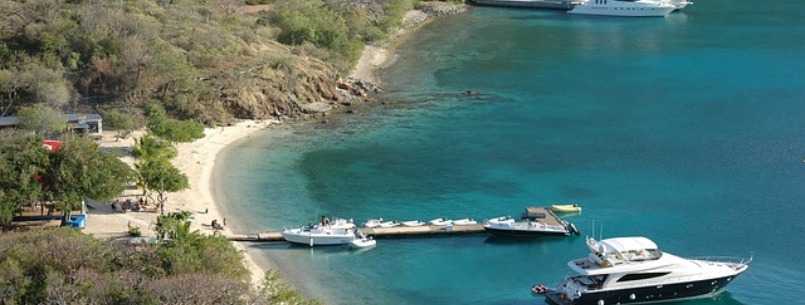
What the British Virgin Islands lack in glitz and historical sites they make up for in unspoiled beauty – stunning tree-covered peaks, secluded coves, long palm-fringed sandy beaches, and spectacular reefs whose breathtaking marine life and numerous shipwrecks make for some of the best diving and snorkeling in the Caribbean.
The largest and most developed island, Tortola, is the main resort center and home to the capital, Road Town.
Quieter Virgin Gorda offers largely upmarket accommodation centered on its own mini-archipelago and watersports playground.
Anegada, the non-hilly Virgin, is a coral atoll teeming with wildlife whose endless beaches, a maze of reefs, and bonefishing pull in day-trippers.
Cayman Islands Beaches
Just south of Jamaica, the Cayman Islands have truly grown over the past thirty years, driven by tourism and banking. The islands have been a scuba-diving paradise since the 1960s.
The Cayman Islands, like all islands, are essentially the tips of underwater mountains, and the submerged terrain around these islands is especially dramatic. The spectacular underwater walls, caverns, and healthy coral reefs have made these islands one of the world’s best spots for diving and snorkeling.
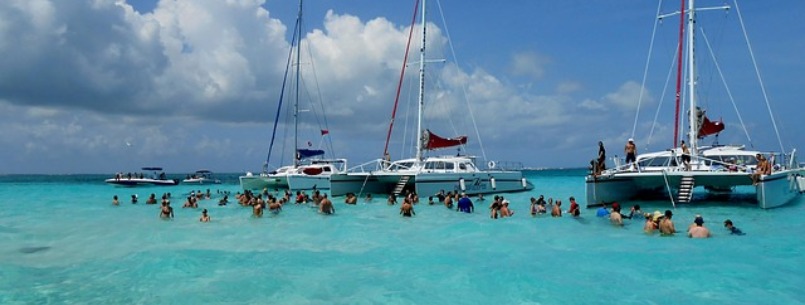
An abundance of natural attractions makes the islands an ideal destination for those who enjoy watersports, birdwatching, laid-back day hikes, clear water, and sandy beaches.
Grand Cayman’s Seven Mile Beach is among the finest beaches in the Caribbean.
Seven Mile Beach is a wide, powder-soft stretch of white sand that curls around the west side of the island. The waters are generally calm, warm, and crystal-clear – owing to the barrier reef that protects the shoreline from large waves and currents.
The slope heading out to sea is an easy and gradual one, ideal for swimming or just wading in. It’s by far the most popular beach around; even so, it never gets towel-to-towel. If you do want to slip away from the crowds, walk west to where there are fewer hotels.
If rousing casinos and wild nightlife are what you seek, these are not the islands to visit. There’s no gambling of any kind here, and beach nudity is forbidden.
Curacao Beaches
Curacao (population 170,000), the largest of the ABC islands, and the administrative center of the Netherlands Antilles remains relatively unknown outside of Holland and the Caribbean.
Originally discovered by the Spaniards in 1499 and taken over by the Dutch in 1634, Curacao has been slower to develop the kind of tourist industry its neighbors are famed for, though it’s capital city – and recently designated UNESCO World Heritage Site – Willemstad, rivals any in the Caribbean for picturesque charm.
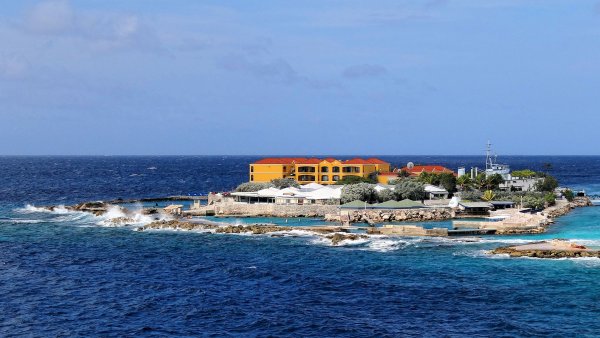
The island also offers decent diving and swimming possibilities, especially on the leeward side, with its secluded coves.
Some of the island’s best beaches, diving and snorkeling sites are found along this northwest stretch of Curacao.
The most popular spots, both on Knip Bay, are Grote Knip with its calm, turquoise-blue waters and beautiful sandy beach nestled in a protected cove, and the smaller Kleine Knip, a few kilometers south of Grote Knip.
Both beaches offer superb swimming and snorkeling opportunities and are crowded on weekends and holidays; a small snack bar and changing facilities are available at Grote Knip. Watch out for the poisonous manchineel trees growing by the beach.
Dominican Republic Beaches
The Dominican Republic, which occupies the eastern half of the island of Hispaniola, is a hugely popular destination, thanks to the portion of the country that most resembles the image of a Caribbean playland: crystal-clear waters and sandy beaches lined with palm trees, both of which the Dominican Republic has plenty of.
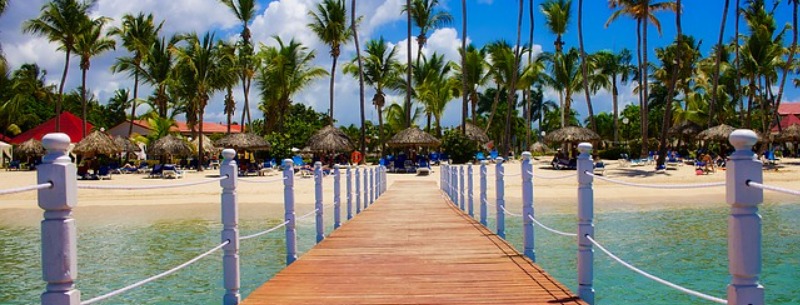
The Dominican Republic, located on the most geographically diverse Caribbean island, boasts virgin alpine wilderness, tropical rainforests, and mangrove swamps, cultivated savannas, vast desert expanses, and everything in between within its relatively small confines, providing astounding opportunities for ecotourism and adventure travel.
Dominican Republic Beach Guide
Grenada Beaches
While largely dependent on agriculture, the tiny nation of Grenada – which includes neighboring Carriacou and Petite Martinique as well as other smaller Grenadine islands – is steadily earning a reputation as a holiday destination, but it remains relatively unspoiled compared to other more popular Caribbean islands.
All three of the main islands offer excellent watersports opportunities, while Grenada in particular has its share of stunning black- and white-sand beaches, ranging from the resort-lined Grand Anse Beach on the southwest tip to the ruggedly spectacular Bathway Beach in the northeast.
Most people’s experience of Grenada begins and ends with the stunning Grand Anse Beach, a 1.3-mile stretch of white sand with a stunning view of St George’s and the surrounding hills.
Even on busy days, large pockets of peace and quiet can be found amidst the gaggles of tourists that congregate near their hotels. The sea is exquisite and there is no shortage of opportunities to water-ski, windsurf, or be pulled around the bay in an inflated inner tube by speedboat.
The Craft and Spice Market selling jewelry, clothes, and the ubiquitous spices (daily 8 am-6 pm) is situated at the north end of the beach, which also has a number of small refreshment bars, as well as showers and toilets. Lockers can be hired from the sea-damaged Cot Bam restaurant halfway along the beach.
Just south of Grand Anse on the other side of Quarantine Point lies Morne Rouge. Having fewer resort complexes and being slightly harder to reach, this smaller and shadeless beach has an air of exclusivity and is excellent for swimming, snorkeling, and private sunbathing.
The next beach along the coast, just past Petit Cabrits Point, is the even more isolated Portici Beach, which is accessible from the main road to the airport – just take the turn marked “Beach House Bar and Restaurant” and follow the dirt track down to the shore.
The walk from the airport takes about twenty minutes, so if your plane is delayed you can while away your time on the sands rather than in the departure lounge. Here, if anywhere, you’ll bump into the rich and famous who visit Grenada – the beach backs onto the exclusive resort of La Luna.
Guadeloupe Beaches
The largest French West Indian island, Guadeloupe encompasses a massive 1704 square kilometers, the majority of which is taken up by its two adjoining mainland islands, Basse-Terre and Grande-Terre, whose outline resembles a green-backed butterfly in flight.
Most of the action happens along Grande-Terre’s southern coast, where one white-sand beach after another seems to merge endlessly along the coast, with the stunning Plage Caravelle forming the centerpiece.
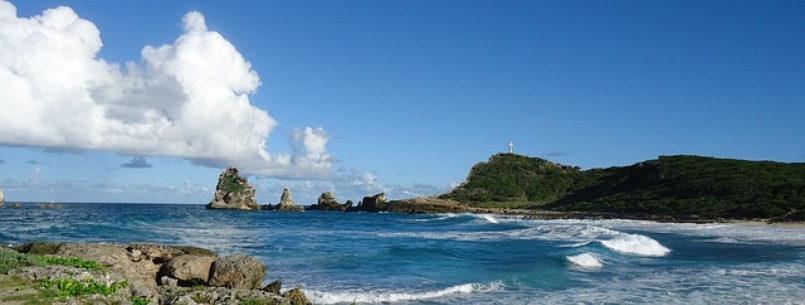
Its outer reaches are pounded by the savage Atlantic Ocean to produce jagged limestone outcroppings like the windswept Pointe-des-Chateaux and the exquisite Lagon de la Porte d’Enfer natural swimming pool.
The French West Indies’ top dive site lies 4km south of La Traversee on the N2, off Plage Malendure, a sliver of dark volcanic sand that can get brutally crowded in high season as busloads arrive for the thrice-daily diving outings offered by numerous beachside outfits.
Terrific beaches and attractive architecture make tiny Terre-de-Haut the most striking of Guadeloupe’s outer islands.
Jamaica Beaches
Beautiful, brash Jamaica is well-known for its beaches and music, but it is so much more.
There’s plenty of white sand, turquoise sea, and swaying palm trees, but there are also breathtaking mountains and rivers, cascading waterfalls, and cactus-strewn savannah plains.
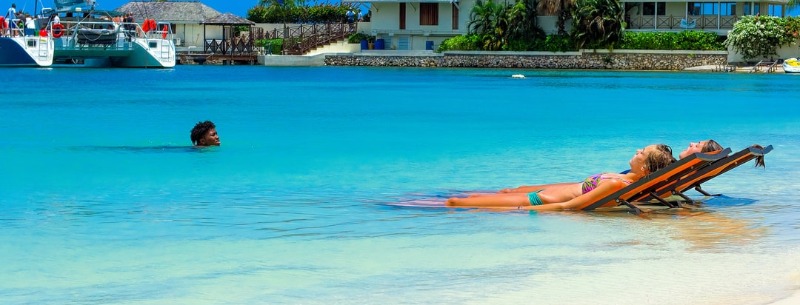
The island is much more than a resort; it also has vibrant towns and cities like sprawling Kingston, which inspired the music of Bob Marley and countless other home-grown reggae superstars.
Jamaica, as the birthplace of the “all-inclusive” hotel, is ideal for those who want to go straight from the plane to the beach, never leaving their hotel compound. But, in order to get a sense of the country, you’ll need to do some exploring.
Martinique Beach Guide
Visitors to Martinique will have to do some legwork to discover the island Columbus once lauded as the “most charming country there is in the world”.
Aggressive development has resulted in resort towns complete with artificial beaches and pastel-hued cement hotels more appropriate to a Florida landscape than the French West Indies.
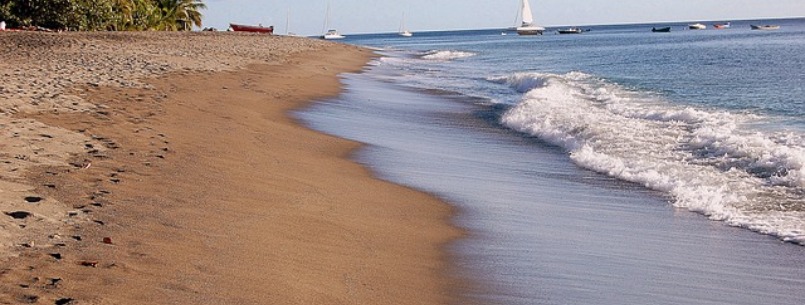
That said, Martinique’s resort emphasis makes the island ideal for all-inclusive travel, and most resorts organize optional day trips to the spots that give an idea of what brought the developers here in the first place.
The villages like isolated Grand’ Riviere and Atlantic-facing Tartane steadfastly retain the customs emblematic of traditional Caribbean fishing villages; the latter, on the Presqu’lle Caravelle, is also the island’s most laid-back destination, a wonderfully underdeveloped stretch that boasts some of Martinique’s finest beaches.
The stupendous Les Salines, 5km south of Ste-Anne, is considered Martinique’s best beach with good reason: its pristine white sand trims an azure bay framed by swaying palm trees.
Should you get bored with sun-worshipping, the sand is backed by a natural salt pond, for which the beach is named, and borders a desolate petrified forest, La Savane des Petrifications; both make good side-explorations.
While the beach has countless snack trucks selling baguettes, crepes, and drinks, its facilities aren’t spectacular – if possible, do your suit in advance.
The island’s beaches get increasingly black as you head north, culminating in the breathtaking Anse Couleuvre at the island’s furthest reaches – the place to go for total isolation.
Puerto Rico Beach Guide
Geographically, Puerto Rico is a Caribbean hub, presiding squarely over the waters between Hispaniola and the Virgin Islands. As a commonwealth of the US, however, it remains a world apart from its island neighbors, over a distance that can be measured not just in kilometers, but in dollars.
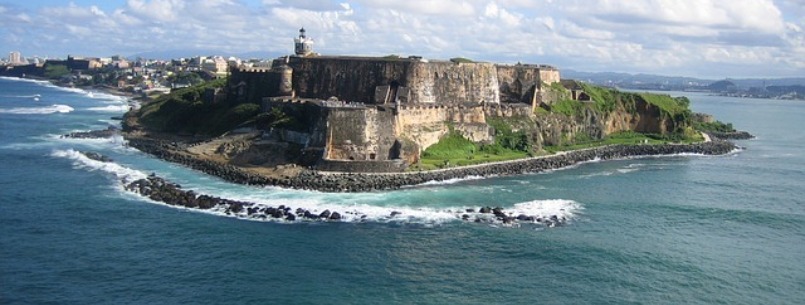
Despite the threat of overdevelopment from US dollars, most of the 35-by-100-mile island has managed to elude despoilment. Even in the crowded capital, it’s hard to find a sullied beach, and outside the major cities nature is largely untouched – especially in the jungly, mountainous interior; on the relatively hidden beaches along the southwest coast; and on the offshore islands.
In fact, the rich natural resources and wide range of hiking, birding, diving, and caving opportunities make Puerto Rico as much a magnet for eco-tourists as for sun-worshippers.
Even if you’re staying in Puerto Rico for just a week, it’s worthwhile to catch a ferry or hop a puddle-jumper to Vieques or Culebra, the two relatively undeveloped islets off the eastern coast known as the Spanish Virgin Islands – and geologically a part of the Virgin Islands.
Snorkeling, diving, fishing, and swimming are superlative here, and ravishingly beautiful, often isolated, beaches abound on both islands.
Saba Beaches
At the top of the Eastern Caribbean chain, and despite covering just thirteen square kilometers, Saba has plenty of small delights.
Its quaint villages are neat and attractive places, its main road swept clean daily and largely free of the traffic that plagues nearby islands.
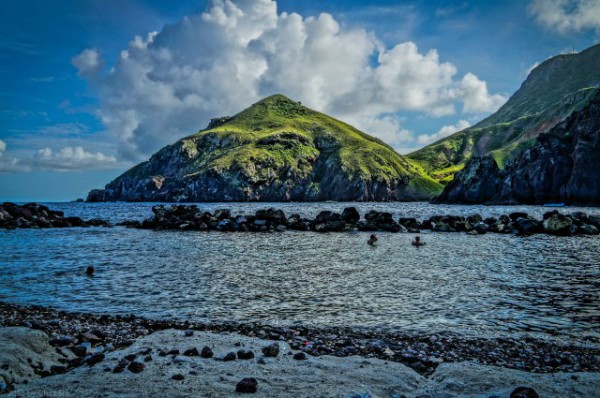
Even more appealing, the island’s volcanic origins and limited development mean that spectacular vegetation and scenery are within easy reach of the main villages, and an even more spectacular world of coral and fish just yards offshore.
Superb diving is the reason most tourists make it to Saba. A marine park was designated in 1987, and carefully controlled operation of the dive sites scattered throughout the park (which surrounds the entire island) has kept the reefs in pristine condition. Visibility is excellent and, as well as fine coral heads near the surface for snorkeling, there are sheer walls dropping to over 300m just offshore.
Most of the best dive sites are on the calmer, western side of the island, where you’ll find great pinnacle dives as well as ridges and beautiful coral gardens.
West of The Bottom, a road plows through to Saba’s only beach of note at Wells Bay, where you’ll find a rather uninspiring patch of sand, though it makes a good spot to snorkel.
St. Barths Beaches ( St. Barthelemy )
The Caribbean playground of the rich and famous, the diminutive 25-square-kilometer St. Barths looks like it’s been plucked from the Cote d’Azur and dropped into the Antilles.
Situated 25km south of St. Martin and 175km north of Guadeloupe, the boomerang-shaped island is sprinkled with picturesque red-roofed villas and edged by some of the Caribbean’s loveliest beaches and bays.
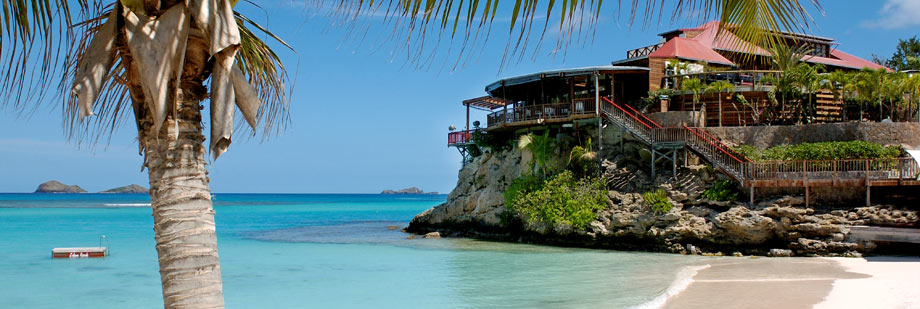
Many of the beaches are only accessible by sea, giving the island a rare sense of seclusion.
Even the most beautiful beaches – Grande Saline, AnseColombier, and Anse Gouverneur – never get crowded and, thanks to building laws forbidding big resort developments, everything is small-scale, including the capital, Gustavia, whose tallest buildings are shorter than the highest palm trees.
Two of St Barts’ best-undeveloped beaches are approached from well-marked secondary roads south of St-Jean and Lorient.
The local favorite is the white-sanded Grande Saline that backs a salt pond at the island’s core.
The other beach, the facility-less Anse Gouverneur, lies around another headland, at the end of a steep descent that passes hidden villas and marvelous views of St-Jean.
St Barths’ privacy doesn’t come cheaply, but considering the throngs that crowd the island’s neighbors in high season, paying a little more for some personal space can make all the difference.
St. Kitts & Nevis Beaches
The South-Eeast Peninsula, which extends towards Nevis from Frigate Bay, boasts grassy peaks and St Kitts’ finest beaches.
You’re likely to spot one of the island’s numerous vervet monkeys as you head south to the peninsula’s most happening pocket, Turtle Beach, home to a lively beach bar and restaurant, the Purple Turtle.
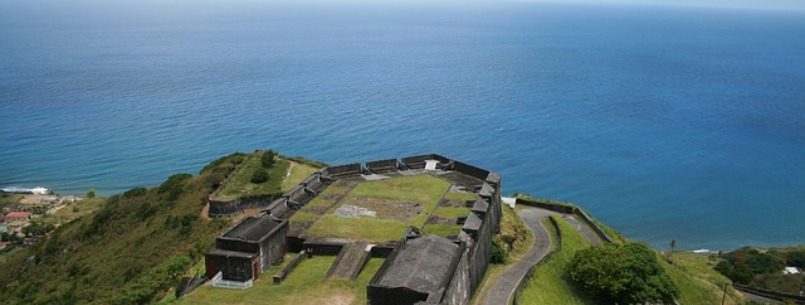
The shores around Booby Island, an islet facing the beach, abound with marine life, providing good snorkeling and diving. The one downside is the beach’s popularity with cruise-ship day-trippers.
If things get too busy, nearby Cockleshell Beach, around a hill to the west, is a good alternative.
Halfway down the western coast, White HouseBay fronts a modest stretch of sand with some of the best snorkeling on the island, thanks to a shallow-lying shipwreck just offshore.
Further up the west coast from Charlestown, Oualie Beach graces a calm cove with the island’s greatest concentration of watersports outfits right on the sand.
After Oualie Beach, the island road wraps around the northern slopes of Mount Nevis and passes the airport before reaching Nisbet Beach, Nevis’ nicest. Its deep white sand, facing the Atlantic, is scattered with elegant coconut trees strung with hammocks.
St. Lucia Beaches
St. Lucia more than lives up to the paradisal Caribbean stereotype: a glorious mix of honey sand beaches, translucent waters sheltering reefs swarming with tropical fish, and lush interior rainforests.
However, in contrast to other islands in the region, where the tourism infrastructure has been steadily expanding since the 1960s, St Lucia has only recently begun to attract visitors in any number. As a result, tourism has a much lower profile here, and this low-key feel is one of the island’s biggest assets.
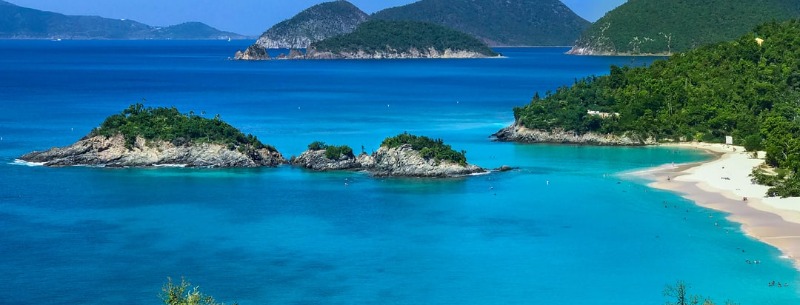
Despite the lack of hype, St Lucia’s tourist facilities are top-notch, and, unusually, cater to all budgets – you can stay at luxury hotels or inexpensive guesthouses, dine in world-class restaurants or at roadside kiosks, and shop in large duty-free malls or at open-air village markets.
Rodney Bay is the most popular resort area, with a deep-water yacht harbor and a marina complex housing several rather shabby shops and restaurants, as well as the restaurant-and-hotel-lined Reduit Beach, one of St Lucia’s most popular, and least local, strips of sand.
The west coast of St Lucia is incredibly beautiful, rich, and varied in its attractions and notable for its pretty beaches and, in parts, its decided lack of tourist traffic.
You can search out isolated waterfalls, hike through astounding rainforests, swim, snorkel, and scuba dive in secluded bays and visit peaceful fishing villages, all without the commercial feel of the northwest coast.
St. Martin / St. Maarten Beaches
Shared between the French and the Dutch since the mid-seventeenth century, the tiny island of St. Martin / St. Maarten is one of the most touristed islands in this part of the Caribbean and has a huge duty-free shopping area.
The island does boast some of the finest beaches in the Eastern Caribbean, particularly at Orient Beach on the French side, as well as some stunning scenery, most notably in the interior around Pic Paradis, and many excellent restaurants and hotels on both sides of the border.
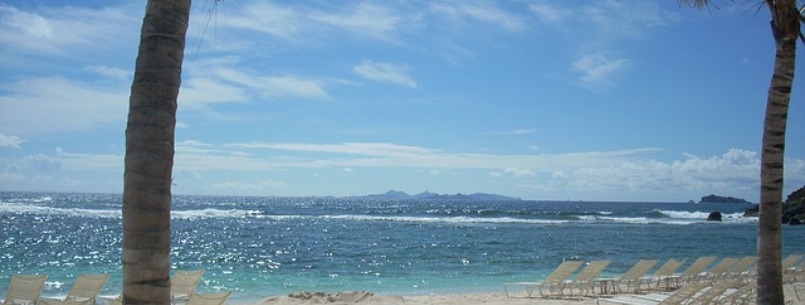
On the other hand, the hunt for the tourist dollar can feel unrelenting and, at times, it is hard to discern the real country under the veneer of concrete development, souvenir shops, and the waves of tourists.
If all you want to do is lie on the beach and play in the sea, both St Martin and St Maarten are not bad options.
Traveling between the French and Dutch sides is hassle-free and there are no border crossing formalities.
St. Vincent and the Grenadines Beaches
Situated about one hundred miles west of Barbados, and nestled between St Lucia to the north and Grenada to the south, the string of islands known collectively as St. Vincent and the Grenadines may be physically close together, but vary enormously in character, terrain, and appeal.
St. Vincent is famous for its black beaches of volcanic sand, found along its entire coastline.
The Leeward (west) side of the island is characterized by secluded coastal valleys and fishing villages, while the dramatic Windward (east) side, lined with windswept beaches, is pounded by the waves of the Atlantic Ocean.
The main tourist areas of Villa Beach and Indian Bay and the luxury resort of Young Island have the most popular beaches, though more appealing beaches lie in the more remote parts of the island.
No visit to St. Vincent and the Grenadines is complete without a stop on Bequia island, where the beaches are breathtaking and the inhabitants friendly.
Trinidad and Tobago Beaches
Trinidad and Tobago, located just off the coast of the former South American mainland, are the southernmost islands of the Lesser Antilles chain and the most powerful republic in the Eastern Caribbean.
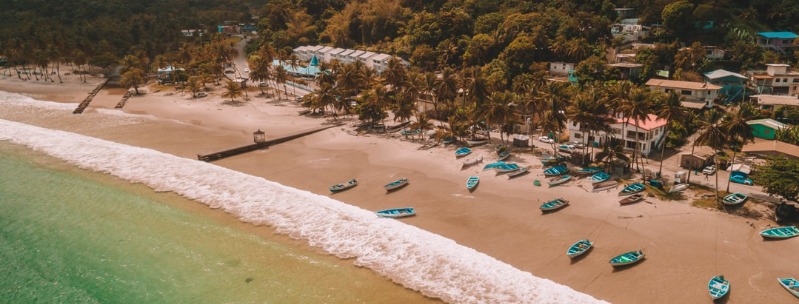
They are the most exciting, unexplored, and natural Caribbean islands, with a rich indigenous culture. Regionally, Trinidad and Tobago are the richest eco-tourism destinations, combining Caribbean flora and fauna with the wilder aspects of the South American mainland.
Trinidad and Tobago Beach Guide
Turks and Caicos Beaches
Just twenty years ago, the Turks and Caicos Islands were one of the quietest and least-known destinations in the West Indies.
Today, on the back of classy development on Providenciales, and great beaches and diving on all of the islands, they have become one of the most fashionable places to visit in the region.
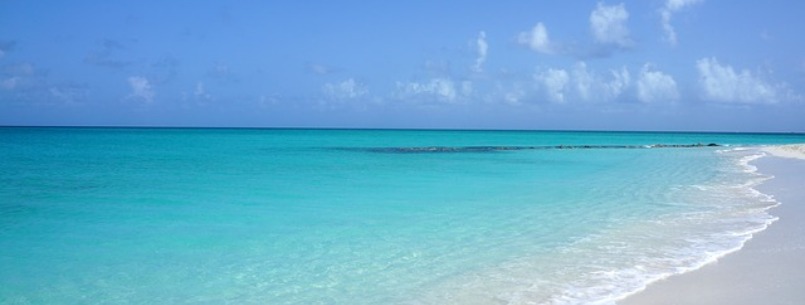
The country comprises two groups of islands – eight inhabited and around forty uninhabited – separated by the Columbus Passage, a deep-water channel 22 miles wide and up to 6000 feet deep.
The major attractions on all of the islands are concentrated along their coasts: truly sensational white-sand beaches that stretch for miles, and world-class diving, snorkeling, and deep-sea fishing and bonefishing.
Inland, there’s not much to see other than low-lying scrubby vegetation and, particularly in the Turks Islands, large expanses of featureless salinas, from which Bermudian settlers and traders harvested salt during the islands’ early development.
US Virgin Islands Beaches
With its sea-swept landscapes, historic towns, duty-free shopping, and luxurious resorts, the US Virgin Islands bask in the combination of familiar yet exotic that makes them one of the most popular cruise-ship destinations in the Caribbean.
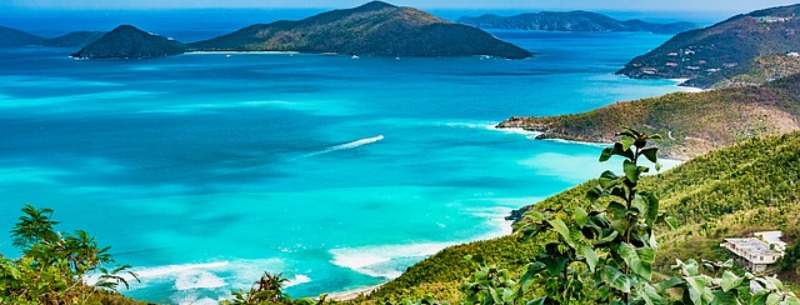
Of the sixty islands, islets, and cays (most of which are uninhabited) that make up the US Virgin Islands, the biggest and busiest are St. Thomas, St. Croix, and St. John.
Each has a distinctive mood and culture, and you haven’t really seen the US Virgin Islands until you’ve checked out all three.
